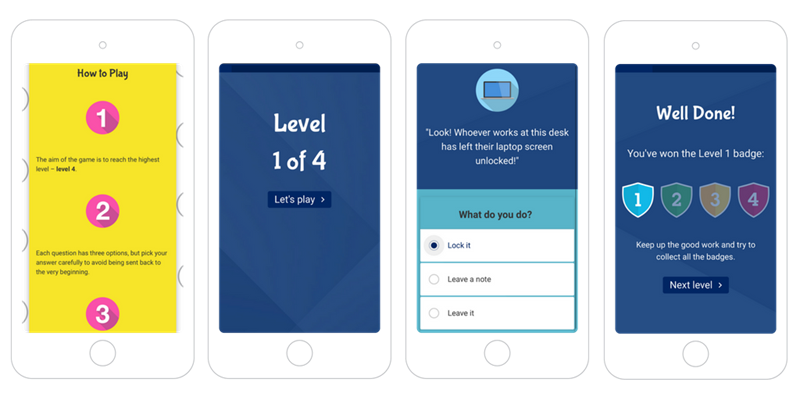Ethics & Compliance Learning
Gamification of Ethics and Compliance Program
Gamification is the technique of applying the science and psychology of gaming to non-game experiences – like ethics and compliance learning.
Ethics and compliance is inherently a very serious concern for organizations, with severe consequences if incidents occur. As part of their compliance programs, many organizations complement traditional training with awareness communications, but the nature of the content can influence how the message is delivered and consumed – and not always in a good way. As a result, ethics and compliance learning can often lack creativity and, to the learners who have to complete it, feel dry, distant, and repetitive.
As compliance officers aspire to make their programs more effective, learning experience designers like me relish the challenge of creating thought-provoking, relevant, and engaging experiences that genuinely build awareness, and the motivation and skills to actively minimize risk. To succeed, we're always looking beyond the world of learning for new approaches to designing effective ethics and compliance content. Recently, many people have been getting excited about one approach in particular – 'gamification.'
A game on two wheels
Let me share an example. As an avid cyclist, I spend much of the summer dressed in Lycra, huffing and puffing my way up and whizzing down hills, all in the pursuit of a basic level of fitness. But despite my love for it, I sometimes found it quite tough to motivate myself to get out on the bike. It was so easy to find excuses: “I'm too busy,” or “I'm too tired,” or “I live in the UK and it's too wet and windy.” To my trainer's dismay, I often simply convinced myself that I didn't need to ride that day.
But then I discovered a brilliant cycling tracker app for my iPhone that helps me see how all my efforts are worthwhile. I can track how far I've cycled, how many calories I've burned, how fast I've gone, and then compare it all to my previous rides. When I get home from a ride, I post it all on social media and bask in the glow of my achievements. As I continue riding, I set new goals for myself. My first 50 mile ride? Check. 1000 miles in a year? Check. First 100 mile ride? Ask me in a few months.
This cycling tracker app is a great example of 'gamification' – the technique of applying the science and psychology of gaming to non-game experiences. The points, badges, goals, and the social and competitive elements in the app, all motivate me to engage, encourage me to progress, challenge me to improve and drive me to compete. For me, this makes me cycle more, cycle better, and help me achieve my objective of keeping fit and healthy.
Gamification is the technique of applying the science and psychology of gaming to non-game experiences.
Me, on my way to knocking out that 100-mile ride
Life's a Game
Gamification is everywhere. From the supermarket and coffee shop loyalty programs that award us points and special discounts the more we buy, to the dieting programs that reward us with badges for sensible food eaten and weight lost. There are even gamified running apps that simulate a swarm of zombies chasing us for extra motivation on our daily jogs.
My issue on the bike was that I couldn't tell if my cycling was doing me any good, yet I was certainly feeling the pain. However, the features and design of the cycling tracker app, and especially its use of gamification elements, enabled me to continually see the value I was driving from my efforts, which motivated me to increase my activity.
As the benefits that compliance officers desire from their compliance programs grow more ambitious, it becomes even more essential to innovate in the design of ethics and compliance learning solutions. Similarly, learners who have become fatigued by their experiences with ethics and compliance training year on year are also demanding innovation, and expect digital learning to reflect their experiences in the broader digital world.

Information Security “Blindspot” Gamified Pre-Training Experience with SAI Global
Designing Learning Experiences that Drive Outcomes
The 'gamification' aspect of my cycle tracker app works so well because it reinforces the ultimate purpose of the app, to motivate. The overarching purpose of learning is to deliver change. We design our ethics and compliance learning solutions to change people from potentially presenting a risk, into people able to 'do the right thing', by doing their jobs ethically and in compliance with company policies and the law.
When people don't do the right thing, it's usually because:
- They don't know what the right thing to do is because they lack the knowledge of the risks to which they and the business are exposed.
- They don't believe in the need to do the right thing because their personal attitude to risk is not aligned with that of the business.
- They don't know how to do the right thing because they lack the skills to prevent, recognize, and respond to risk.
- They don't apply their knowledge, attitude and skills because they fail to display the appropriate behaviors to prevent and mitigate risk.
When we clearly define the change our ethics and compliance learning solutions need to deliver, we can design learning experiences to achieve that change. So our challenge is to adopt the most effective instructional methodologies, approaches, and tools to help people do the right thing. Gamification is just one of many powerful tools in our learning design toolbox that we can use to help us succeed.
In future posts, I'll dive deeper into how gaming and gamification can make learning more effective. I'll also explore trends in the value of a campaign-based approach, measuring effectiveness, adaptive learning and much more.
As to how I do on that 100-mile cycle ride – I'll let you know.
